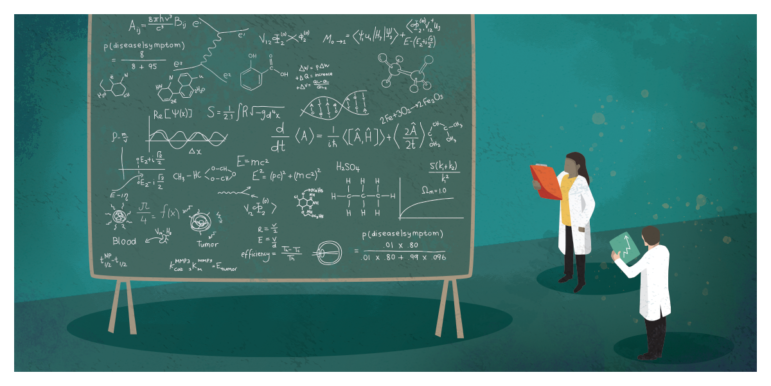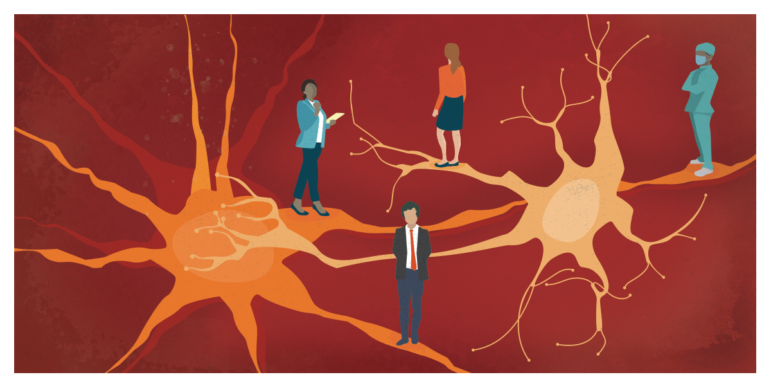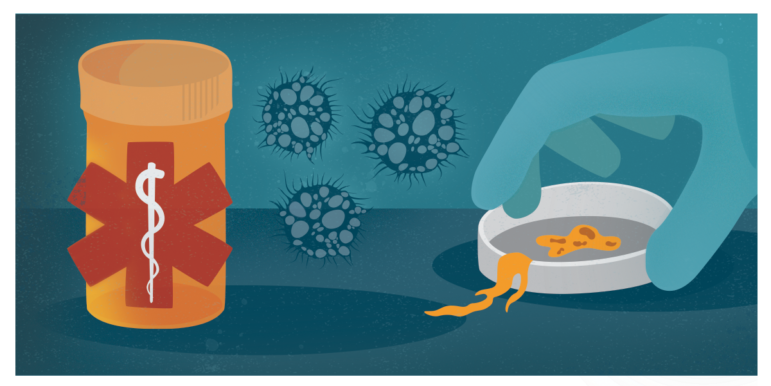

Illustration: Marcelle Louw for GIJN
Health and Medicine Guide: Appendix
Read this article in
Guide Resource
Investigating Health and Medicine
Chapter Guide Resource
Health and Medicine Guide: Preface & Introduction
Chapter Guide Resource
Health and Medicine Guide: Regulating Drugs — Development & Approval
Chapter Guide Resource
Health and Medicine Guide: A Study Is Not Just a Study
Chapter Guide Resource
Health and Medicine Guide: The Scientific Basis of Influence
Chapter Guide Resource
Health and Medicine Guide: Behind-The-Scenes Reporting Strategies
Chapter Guide Resource
Health and Medicine Guide: Reporting About Safety
Chapter Guide Resource
Health and Medicine Guide: Tips on Traps, Hype & Ethics
Chapter Guide Resource
Health and Medicine Guide: Appendix
Appendix A: Glossary of Terms
Accelerated Approval
A regulation that allows drugs for serious conditions that fill an unmet medical need to be approved based on a surrogate endpoint (for Surrogate Endpoint or Surrogate Outcome check below of this Glossary).
Adverse Event Reporting (AER)
Reports filed by patients and medical professionals to national and international regulatory bodies regarding adverse reactions to medical drugs and devices. See, for example, the US FDA’s system here.
Bio-Markers
Biological markers refer to a broad subcategory of medical signs — that is, objective indications of the medical state of a patient, observed from outside the patient — and which can be accurately measured and the findings reproduced. For example, a blood test result. Medical signs stand in contrast to medical symptoms, which are limited to those indications of health or illness perceived by patients themselves.
Blinding
When study participants do not know if they are receiving an intervention/treatment or a placebo. If a study is double-blind, medical providers administering the treatment do not know either. Many studies have shown that if you know what treatment you are receiving, you’ll eventually experience greater placebo effects than a subject who doesn’t know what treatment s/he is having.
Confounding Factors and Bias
A confounding factor is an element that might influence the results of a study or analysis. For instance, comparing the mortality of two countries, without adjusting for population age; there are countries with a much older population than others, and this can greatly influence the comparison of mortality rate. In this example, population age is the confounding factor. When analyzing a dataset or a study result, researchers try to make adjustments to control for any confounding factor, thus achieving a more reliable answer to the research question. Bias is defined as any “non-random error” that interferes with an accurate assessment of a study outcome. A bias can not be controlled during analyses. More: Identifying and Avoiding Bias in Research.
Control Group
Both observational and experimental studies must include a “control group” in which the participants receive the “usual care”, “no treatment” or a “placebo treatment”, and not the intervention (treatment) under investigation. Control groups are necessary to allow understanding of what would have happened in the absence of the new treatment.
Correlation versus Causation
Correlation: when two phenomena are linked by a relationship. For instance, it’s raining and at the same time, the lights go off in your apartment. These two events happen at the same time, so there is a sort of relationship, but you can’t say if the lights went off because of the rain. Causation, conversely, indicates that two phenomena are linked by a cause and effect relationship. In the example, you call up a specialist to fix your electricity problem and he explains to you that clearly a leak in your building meant the rain shut the lights off. In scientific methodology, the difference between correlation and causation is key. Many phenomena can seem linked by a cause and effect relationship, but unless proven we must assume that they are just correlated. Attributing a causation value to a phenomenon is a very common and problematic bias.
Critical Appraisal
One definition in relatively plain language: “Critical appraisal is the process of carefully and systematically assessing the outcome of scientific research (evidence) to judge its trustworthiness, value, and relevance in a particular context.” Source: What is Critical Appraisal?— Center for Evidence Based Management.
Disease Mongering
One definition of disease mongering is the “selling of sickness” in order to promote drug sales. It is a strategy used by pharmaceutical companies to enlarge the potential market for their products, either by inventing new illnesses, or by framing a normal phenomenon as such. Common symptoms, though not pathological, can become the indication for a new drug, or a new indication for an already marketed product.Accelerated Approval
A regulation that allows drugs for serious conditions that fill an unmet medical need to be approved based on a surrogate endpoint (for Surrogate Endpoint or Surrogate Outcome check this Glossary).
Endpoints: Primary, Secondary, Surrogate, Combined
A clinical trial aims to answer a research question. The “endpoints” are indicators established to measure the trial’s result. For instance, a trial for a new oncological drug could set as its primary endpoint prolonging the patient’s life, and as secondary endpoint the time without symptoms. Surrogate endpoints are inherently a red flag; in this example that could be the size of the tumor. Combined endpoints use two or more outcomes as a single measure; beware of this as it might bias the study results.
European Medicines Agency (EMA)
The EMA is an agency of the European Union in charge of the evaluation and supervision of medicinal products. Along with the US Food and Drug Administration, the agency’s decisions on drugs have great influence on the worldwide pharmaceutical market.
Evidence-Based Health Care
The term indicates an approach used by health care providers to decide on appropriate intervention to treat a condition, basing the decision-making process on the “best evidence available.” More: Evidence Based Health Care.
Experimental (also called Interventional) Study
A study where all the conditions are pre-determined and controlled by the person carrying out the experiment. In this design, the investigators are performing an experiment on the people they study by administering the intervention/treatment to some of them (intervention group), and not to the others (control group). In randomized controlled trials, the allocation of people to intervention or control groups is done by chance (at random). More: Experimental Study definition.
Exposure
Exposure is the term used to describe an intervention (in an experimental trial) or a risk factor (in an observational study). People are said to be exposed (or un-exposed) if they received (or did not receive) the intervention investigated.
Exposure in Absolute Values (Absolute Risk)
Conversely to relative risk, the absolute risk gives an indication of the likelihood over time of an event happening. See this website for accurate but plain language definitions, and many examples: Relative Risk and Absolute Risk: Definition and Examples.
Fast Track
A process designed by the American Food and Drug Administration (FDA) to facilitate the development, and expedite the review of drugs to treat serious conditions and fill an unmet medical need.
Field Safety Notice
The notice a manufacturer releases to acknowledge that a serious safety concern regarding the use of its product has emerged.
Food and Drug Administration (FDA)
The FDA is a US regulatory agency responsible for supervision of pharmaceutical drugs, vaccines, and medical devices. Along with the European Medicines Agency, the FDA’s decisions on drugs have great influence on the worldwide pharmaceutical market.
Indication
An indication describes the approved use of a pharmaceutical product (such as a drug, test, or vaccine). It means that regulatory authorities have reviewed the evidence submitted by the manufacturer for the treatment or test of a condition or a disease, and allowed the company to market the product for this specific use. Widening the indication is a common practice to expand a product’s market, and it often happens step by step, with the industry submitting new data to the regulators.
Intervention
The WHO defines a health intervention as: “An act performed for, with or on behalf of a person or population whose purpose is to assess, improve, maintain, promote, or modify health, functioning, or health conditions.” In epidemiology, the “intervention group” describes a group to which the active treatment (intervention) has been administered, as opposed to the “control group” to which the usual treatment or a placebo has been given.
Medical Devices
The full definition of a “medical device” by the WHO: “Any instrument, apparatus, implement, machine, appliance, implant, reagent for in vitro use, software, material or other similar or related article, intended by the
manufacturer to be used, alone or in combination, for human beings, for one or more of the specific medical purpose(s) of diagnosis, prevention, monitoring, treatment, or alleviation of disease; diagnosis, monitoring, treatment, alleviation of or compensation for an injury; investigation, replacement, modification, or support of the anatomy or of a physiological process;
supporting or sustaining life; control of conception; disinfection of medical devices; providing information by means of in vitro examination of specimens derived from the human body; and does not achieve its primary intended action by pharmacological, immunological or metabolic means, in or on the human body, but which may be assisted in its intended function by such means.” More: Medical Device — Full Definition.
Meta-Analysis
A meta-analysis is a statistical analysis that combines the results of several, comparable studies by giving more weight to studies that are considered more reliable. It is best performed following a systematic review of the literature.
Multicentric Double-Blinded Randomized Controlled Trials
Multicentric indicates that a trial is performed in several, different locations (hospitals, for instance). For double-blinded and randomized controlled trials (RCT) see nonrandomized, nonblinded, below.
Nonrandomized, Nonblinded
Randomization is a key concept in scientific studies that aim at comparing two groups of subjects that are receiving different interventions (such as a tested drug and another drug for comparison). By randomly assigning patients to one of the two groups, bias is minimized and confounding factors (known and unknown) are equally distributed among the groups so that the two groups are as much alike as possible at the onset of the study. Nonetheless, by chance alone, in small sized trials, baseline imbalances, such as one group being older than the comparator group, do occur and can skew the outcome.
Observational Study
A study design in which investigators are observing phenomena as they take — or took — place and trying to draw conclusions on their underlying causes without intervening. Although observational studies can provide valuable hints, they can’t provide solid and final evidence, as they are
especially prone to bias and confounding factors. The best course of action is normally to use observational studies to formulate hypotheses, to be confirmed with randomized controlled trials that allow firmer conclusions on the intervention’s effect.
Outcome Switching
Outcome switching is a questionable practice in which researchers modify the aim of the study after it has started, also known as HARKing (Hypothesis After the Results Are Known). Researchers are supposed to identify the expected outcome of the medical intervention being tested in a study protocol before the trial is launched. If that outcome is dropped part way through a study and another outcome is substituted, it could be because the researchers looked at the data and did not get the positive outcome they had hoped for.
Percentage Exposure (Relative Risk)
The US National Institutes of Health defines relative risk as “a ratio of the probability of an event occurring in the exposed group versus the probability of the event occurring in the non-exposed group. For example, the relative risk of developing lung cancer (event) in smokers (exposed group) versus non-smokers (non-exposed group) would be the probability of developing lung cancer for smokers divided by the probability of developing lung cancer for nonsmokers. The relative risk does not provide any information about the absolute risk of the event occurring, but rather the higher or lower likelihood of the event in the exposure versus the non-exposure group.” Source: Relative Risk. It is used as a measure of the strength of an association between an exposure and an outcome.
Pharmacovigilance
According to WHO, “the science and activities relating to the detection, assessment, understanding, and prevention of adverse effects or any other drug-related problem.”
PICO Criteria
PICO is a tool to break down a research question. The acronym stands for: Patient/Population; Intervention; Comparison; Outcomes. Using it allows for a well-structured search in the biomedical literature and it can also be extremely helpful to journalists who need to dig deeper on any medicine-related interventions. More: PICO — Evidence Based Medicine.
Post-Marketing Surveillance
The monitoring of a drug or vaccine safety after it has been put on the market.
Pre-Identified Outcome Measures
See Outcome Switching above.
Premarket Approval Application
In order for a drug or a vaccine to be approved for the market, the manufacturer must submit a Premarket Approval Application, whose aim is to give the regulators all relevant information about the product’s expected effectiveness and safety, as measured in clinical trials.
Randomized Controlled Trials (RCTs)
A randomized controlled trial can be one of the most rigorous ways of determining whether a cause-effect relationship exists between treatment and outcome, and for assessing the cost effectiveness of a treatment.
Comparable groups of subjects are randomly assigned to receive a new medical intervention, or an intervention that is already standard, a placebo, or no intervention at all. If they are single-blinded, the receiver doesn’t know which group they are in, and if they are double-blinded, those administering the intervention do not know either. Such design allows for comparisons between interventions, and it is considered the gold standard among medical studies.
More here: Understanding Controlled Trials: Why Are Randomised Controlled Trials Important?
Retrospective Studies
These are performed looking back at previously collected data. Retrospective studies are observational studies prone to bias, because data was not collected to answer that specific research question.
Surrogate Endpoint or Surrogate Outcome
Surrogate endpoints are indicators (often bio-markers) chosen by researchers because they are considered important contributors in the mechanism of a disease. For example, blood pressure may be used as a surrogate endpoint in a trial on cardiovascular drugs, because it is a known risk factor for heart attacks and strokes. The hypothesis is that if the drug shows an effect on the surrogate endpoint, high blood pressure, it will also have an effect on the clinical outcome (heart attacks and strokes). Unfortunately, in many cases a drug’s effect on a surrogate outcome won’t bring the expected benefit to patients, and may even harm them, because other aspects of the mechanism of the disease have not been well understood yet. That’s why any results obtained in a study that was designed with a surrogate endpoint must be taken with much caution.
World Health Organization (WHO)
The WHO operates under the United Nations to coordinate international responses to public health. Based in Geneva, Switzerland, the agency has six regional offices and 150 field offices worldwide.
Appendix B: Regulatory Agencies
North America
- USA: Food and Drug Administration (FDA)
- Canada: Health Canada
Latin America
- Argentina: National Administration of Drugs, Food, and Medical Devices (ANMAT)
- Belize: Ministry of Health
- Bolivia: Ministry of Health and Social Welfare
- Brazil: Brazilian Health Surveillance Agency (ANVISA)
- Chile: Public Health Institute of Chile (ISPCH)
- Colombia: Ministry of Health and Social Protection / INVIMA Instituto Nacional de Vigilancia de Medicamentos y Alimentos
- Costa Rica: Ministry of Health
- Cuba: Center for State Control of Drugs, Medical Devices and Equipment (CECMED)
- Ecuador: National Agency for Regulation, Control, and Sanitary Surveillance (ARCSA)
- El Salvador: Ministry of Health
- Guatemala: Ministry of Health
- Guyana: Ministry of Health
- Jamaica: Ministry of Health
- Mexico: Federal Commission for the Protection Against Sanitary Risk (COFEPRIS)
- Nicaragua: Ministry of Health
- Panama: Ministry of Health
- Paraguay: Ministry of Public Health
- Peru: General Directorate of Medicines, Supplies, and Drugs (DIGEMID)
- Trinidad and Tobago: Ministry of Health / Bureau of Standards
- Uruguay: Ministry of Public Health
- Venezuela: National Institute of Hygiene “Rafael Rangel” / Autonomous Health Service Comptroller (SACS)
EU and EU Member States
There are several options for applying for a marketing authorization within the EU.
- European Union: European Medicines Agency (EMA)
- Austria: Bundesamt für Sicherheit im Gesundheitswesen (BASG / AGES)
- Belgium: Federal Agency for Medicines and Health Products
- Bulgaria: Bulgarian Drug Agency (BDA)
- Croatia: Agency for Medicinal Products and Medical Devices of Croatia
- Cyprus: Ministry of Health
- Czech Republic: State Institute for Drug Control (SUKL)
- Denmark: The Danish Medicines Agency
- Estonia: State Agency of Medicines
- Finland: Finnish Medicines Agency (FIMEA)
- France: Agence nationale de sécurité du médicament et des produits de santé (ANSM)
- Germany: Bundesinstitut für Arzneimittel und Medizinprodukte (BfArM)
- Greece: National Organization for Medicines
- Hungary: National Institute for Pharmacy and Nutrition (OGYEI)
- Ireland: Health Products Regulatory Authority (HPRA)
- Italy: Agenzia Italiana del Farmaco (AIFA)
- Latvia: State Agency of Medicines
- Lithuania: State Medicines Control Agency (SMCA)
- Malta: Medicines Authority
- Netherlands: Medicines Evaluation Board (MEB)
- Poland: Office for Registration of Medicinal Products, Medical Devices, and Biocidal Products (UPRL)
- Portugal: National Authority of Medicines and Health Products (INFARMED)
- Romania: The National Agency for Medicines and Medical Devices (NAMMD)
- Slovakia: State Institute for Drug Control
- Slovenia: Agency for Medicinal Products and Medical Devices (JAZMP)
- Spain: Ministry of Health, Social Services, and Equality
- Sweden: Medical Products Agency (MPA)
Non-EU Member States
- Albania: National Agency on Drugs and Medical Devices
- Andorra: Ministry of Health and Welfare
- Armenia: Scientific Center of Drug and Medical Technologies Expertise (SCDMTE)
- Azerbaijan: Center of Drug Analytical Expertise of the Ministry of Health of Azerbaijan
- Belarus: Center for Examinations and Tests in Health
- Bosnia and Herzegovina: Agency for Medicinal Products and Medical Devices
- Georgia: Department of Public Health
- Iceland: Icelandic Medicines Agency
- Kosovo: Kosovo Medicines Agency
- Macedonia: Agency for Medicinal Products and Medical Devices
- Montenegro: Agency for Medicines and Medical Devices
- Norway: Norwegian Medicines Agency
- Russia: Federal Service on Surveillance in Healthcare and Social Development
- San Marino: Ministry of Health and Social Security
- Serbia: Medicines and Medical Devices Agency (ALIMS)
- Switzerland: Swissmedic
- UK: Medicines and Healthcare Products Regulatory Agency (MHRA)
- Ukraine: State Inspectorate for Quality Control of Medicines
Asia and The Pacific
- Australia: Therapeutic Goods Administration (TGA)
- Bangladesh: Directorate General of Drug Administration (DGDA)
- Bhutan: Drug Regulatory Authority
- China: China Food and Drug Administration (SFDA)
- Hong Kong: Department of Health / Central Drugs Standard Control Organization
- India: Central Drugs Standard Control Organization (CDSCO)
- Indonesia: Ministry of Health Medical Device Regulatory & CRO
- Japan: Pharmaceuticals and Medical Devices Agency (PMDA)/Ministry of Health, Labour and Welfare (MHLW)
- Kyrgyzstan: Department of Medicines Supply and Medical Equipment
- Laos: Food and Drug Department
- Malaysia: National Pharmaceutical Regulatory Agency (NPRA)
- Maldives: Ministry of Health
- Nepal: Department of Drug Administration
- New Zealand: New Zealand Medicines and Medical Devices Safety Authority (MEDSAFE)
- Pakistan: Drug Regulatory Authority
- Philippines: Department of Health
- Singapore: Health Sciences Authority
- South Korea: South Korea Ministry of Food and Drug Safety
- Sri Lanka: Cosmetics, Devices, & Drugs Regulatory Authority (NMRA)
- Taiwan: Taiwan Food and Drug Administration
- Thailand: Thailand Food and Drug Administration
- Vietnam: Drug Administration of Vietnam
Middle East
- Bahrain: National Health Regulatory Authority
- Iran: Ministry of Health and Medical Education
- Iraq: Ministry of Health
- Israel: Ministry of Health
- Jordan: Jordan Food and Drug Administration (JFDA)
- Kuwait: Kuwait Ministry of Health
- Lebanon: Ministry of Public Health
- Oman: Ministry of Health Sultanate of Oman
- Qatar: MOH Pharmacy and Drug Control Department
- Saudi Arabia: Saudi Food and Drug Authority (SFDA)
- Syria: Directorate of Drug Control
- Turkey: Turkish Medicines and Medical Devices Agency
- United Arab Emirates: Ministry of Health
- Yemen: Supreme Commission for Drugs and Medical Appliances
Africa
- Algeria: Ministry of Health, Population, and Hospitals
- Angola: Direcção Nacional de Medicamentos e Equipamentos / Ministry of Health
- Benin: Ministpre de la santé du Bénin
- Botswana: Drug Regulatory Services / Ministry of Health
- Burkina Faso: Ministère de la Santé et de l’Hygiène Publique Laboratoires (DPMED)
- Burundi: Direction de la pharmacie, du médicament et des laboratoires
- Cabo Verde: Entidade Reguladora Independente da Saúde (ERIS)
- Cameroon: Direction de la Pharmacie, du Médicament et des Laboratoire
- Chad: Direction de la pharmacie, du médicament et de la pharmacopée
- Congo: Direction des pharmacies, du médicament et des laboratoires / Ministry of Health
- Côte d’Ivoire: Direction de la pharmacie, du médicament et des laboratoires (DPML) / Ministry of Health
- DR Congo: Direction de la pharmacie et du médicament (DPM) / Ministry of Health
- Djibouti: Direction du médicament, de la pharmacie et des laboratoires (DMPL) / Ministry of Health
- Egypt: Egyptian Drug Authority (EDA)
- Equatorial Guinea: Direction générale de pharmacie et médecine traditionnelle / Ministry of Health
- Eritrea: National Medicine and Food Administration / Ministry of Health
- Ethiopia: Ethiopian Food and Drug Authority (EFDA)
- Gabon: Direction du médicament et de la pharmacie / Ministry of Health
- Gambia: Medicine Control Agency (MCA) / Ministry of Health
- Ghana: Food and Drugs Authority
- Republic of Guinea: Direction nationale de la pharmacie et du laboratoire / Ministry of Health
- Guinea-Bissau: Ministry of Health
- Kenya: Pharmacy and Poisons Board (PBD)
- Lesotho: Ministry of Health
- Liberia: Liberia Medicines and Health Products Regulatory Authority / Ministry of Health
- Libya: Pharmacy Management Department / Ministry of Health
- Madagascar: Direction de la pharmacie, des laboratoires et de la médecine traditionnelle / Ministry of Health
- Mali: Direction de la pharmacie et des médicaments / Ministry of Health
- Mauritius: Pharmacy Board / Ministry of Health
- Morocco: Direction du médicament et de la pharmacie / Ministry of Health
- Mozambique: Direcção Nacional de Farmácia / Ministry of Health
- Namibia: Namibia Medicines Regulatory Council / Ministry of Health
- Niger: Ministry of Health
- Nigeria: National Agency for Food and Drug Administration and Control (NAFDAC)
- Rwanda: Department of Pharmaceutical Services / Ministry of Health
- Senegal: Direction de la pharmacie et du médicament / Ministry of Health
- Seychelles: Medicines Regulation Unit / Ministry of Health
- Sierra Leone: Pharmacy Board of Sierra Leone / Ministry of Health
- Somalia: Pharmaceutical and Medical Department / Ministry of Health
- South Africa: South African Health Products Regulatory Authority (SAHPRA)
- South Sudan: Food and Drugs Control Authority, South Sudan / Ministry of Health
- Sudan: National Medicine and Poisons Board
- Swaziland: Pharmaceutical Services Department / Ministry of Health
- Tanzania: Tanzania Food and Drug Authority (TFDA) / Ministry of Health
- Tunisia: Direction de la pharmacie et du médicament (DPM)
- Uganda: National Drug Authority
- Zambia: Zambia Medicines Regulatory Authority (ZAMRA)
- Zimbabwe: Medicines Control Authority (MCAZ)
Appendix C: Books
Johan Anderberg, “The Herd. How Sweden Chose Its Own Path Through the Worst Pandemic in 100 Years.” (2022)
Marcia Angell, M.D., “The Truth About Drug Companies: How They Deceive Us and What to Do About It.” (2004)
Michael Blastland, Andrew Dilnot, “The Tiger That Isn’t: Seeing Through A World Of Numbers.” (2007)
Nellie Bly, “Ten Days in a Mad-House.” (1887)
J. Douglas Bremner, M.D., “Before You Take That Pill.” (2008)
Daniel Carpenter, “Reputation and Power: Organizational Image and Pharmaceutical Regulation at the FDA.” (2010)
John Carreyrou, “Bad Blood: Secrets and Lies in a Silicon Valley Startup.” (2018)
Archie L. Cochrane, “Effectiveness And Efficiency: Random Reflections on Health Services.” (1972)
Laura Dodsworth, “A State of Fear: How the UK Government Weaponised Fear During the Covid-19 Pandemic.” (2021)
Katherine Eban, “Bottle of Lies: The Inside Story of the Generic Drug Boom.” (2019)
Allen Frances, “Saving Normal: An Insider’s Revolt against Out-of-Control Psychiatric Diagnosis, DSM-5, Big Pharma, and the Medicalization of Ordinary Life.” (2014)
Gerd Gigerenzer, “Calculated risks: How to Know When Numbers Deceive You.” (2003)
Gerd Gigerenzer, “Reckoning With Risk : Learning to Live With Uncertainty.” (2002)
Ben Goldacre, “Bad Pharma: How Medicine is Broken, and How We Can Fix It.” (2012)
Merrill Goozner, “The $800 Million Pill: The Truth Behind the Cost of New Drugs.” (2005)
Peter C. Gøtzsche, “Mammography Screening: Truth, Lies and Controversy.” (2012)
Peter C. Gøtzsche, “Deadly Medicines and Organised Crime: How Big Pharma Has Corrupted Healthcare.” (2013)
Toby Green, Thomas Fazi, “The Covid Consensus.” (2023)
Katharine Greider, “The Big Fix: How the Pharmaceutical Industry Rips Off American Consumers.” (2003)
Iona Heath, “Matters of Life and Death: Key Writings.” (2007)
Carl Elliott, “The Occasional Human Sacrifice: Medical Experimentation and the Price of Saying No.” (2024)
Darrell Huff, “How To Lie with Statistics.” (1954)
Jon Jureidini, Leemon B. Mchenry, “The Illusion of Evidence-Based Medicine: Exposing the Crisis of Credibility in Clinical Research.” (2020)
Robert M. Kaplan, “Disease, Diagnoses, and Dollars: Facing the Ever-Expanding Market for Medical Care.” (2009)
Jerome P. Kassirer, M.D., “On The Take: How Medicine’s Complicity with Big Business Can Endanger Your Health.”
Christopher Lane, “Shyness: How Normal Behavior Became a Sickness” (2008)
James Le Fanu, “The Rise and Fall of Modern Medicine.” (2000)
Jacky Law, “Big Pharma: How The World’s Biggest Drug Companies Control Illness.” (2006)
John Le Carré, “The Constant Gardener.” (2005)
Jeanne Lenzer, “The Danger Within Us: America’s Untested, Unregulated Medical Device Industry and One Man’s Battle to Survive It.” (2017)
Barry Meier, “Pain Killer: An Empire of Deceit and the Origin of America’s Opioid Epidemic.” (2018)
Ray Moynihan, Alan Cassels, “Selling Sickness: How the World’s Biggest Pharmaceutical Companies Are Turning Us All into Patients.” (2006)
Ray Moynihan, Barbara Mintzes, “Sex, Lies and Pharmaceuticals.” (2010)
Siddhartha Mukherjee, “The Laws of Medicine: Field Notes from an Uncertain Science.” (2015)
Vinayak K. Prasad, Adam S. Cifu, “Ending Medical Reversal: Improving Outcomes, Saving Lives.” (2015)
Vinayak K. Prasad, “Malignant: How Bad Policy and Bad Evidence Harm People with Cancer.” (2020)
Marc A. Rodwin, “Conflicts of Interest and the Future of Medicine.” (2011)
Peter Rost, “The Whistleblower: Confessions of a Healthcare Hitman.” (2006)
Tim Schwab, “The Bill Gates Problem: Reckoning with the Myth of the Good Billionaire.” (2023)
Sergio Sismondo, “Ghost-Managed Medicine: Big Pharma’s Invisible Hands.” (2018)
H. Gilbert Welch, “Should I Be Tested for Cancer?: Maybe Not and Here’s Why.” (2006)
H. Gilbert Welch, Lisa Schwartz, Steve Woloshin, “Overdiagnosed: Making People Sick in the Pursuit of Health.” (2012)
Steven Woloshin, Lisa M. Schwartz, H. Gilbert Welch, “Know Your Chances: Understanding Health Statistics.” (2008)
About the Authors
Serena Tinari and Catherine Riva are medical investigative journalists and co-founders of Re-Check.ch, a Swiss nonprofit organization dedicated to investigating and mapping health affairs. Re-Check.ch produces multi-language publications, supports newsrooms on their health investigations, and gives workshops on how to perform in-depth research on medicine and public health.
Tinari has been working across print and electronic media, radio, and television since 1994. She authored dozens of investigative stories for the Swiss public broadcaster. Tinari specializes in drug safety, Evidence-Based Medicine and conflicts of interest. A trainer, speaker, and moderator, she has reported extensively on Swine Flu and Tamiflu.
Riva specializes in the design and methodology of clinical trial, public health, and Evidence-Based Medicine. A trainer and a speaker, Riva has reported on the Mediator case, breast cancer screening programs, the controversies related to HPV vaccination, and on conflicts of interest in healthcare and medical research. She has also published in biomedical journals.

















